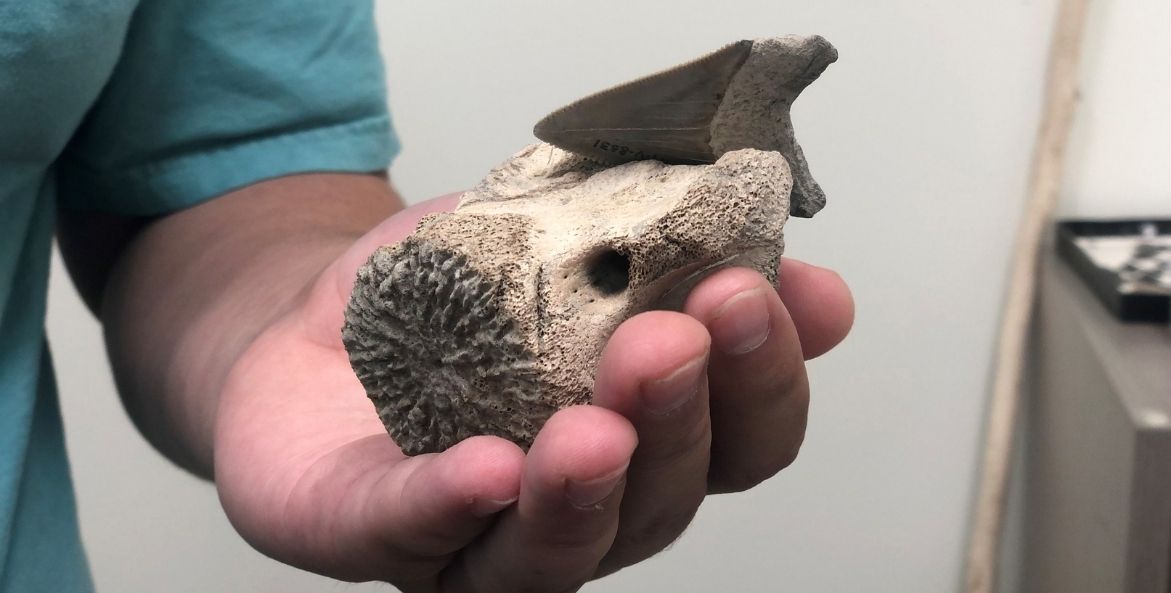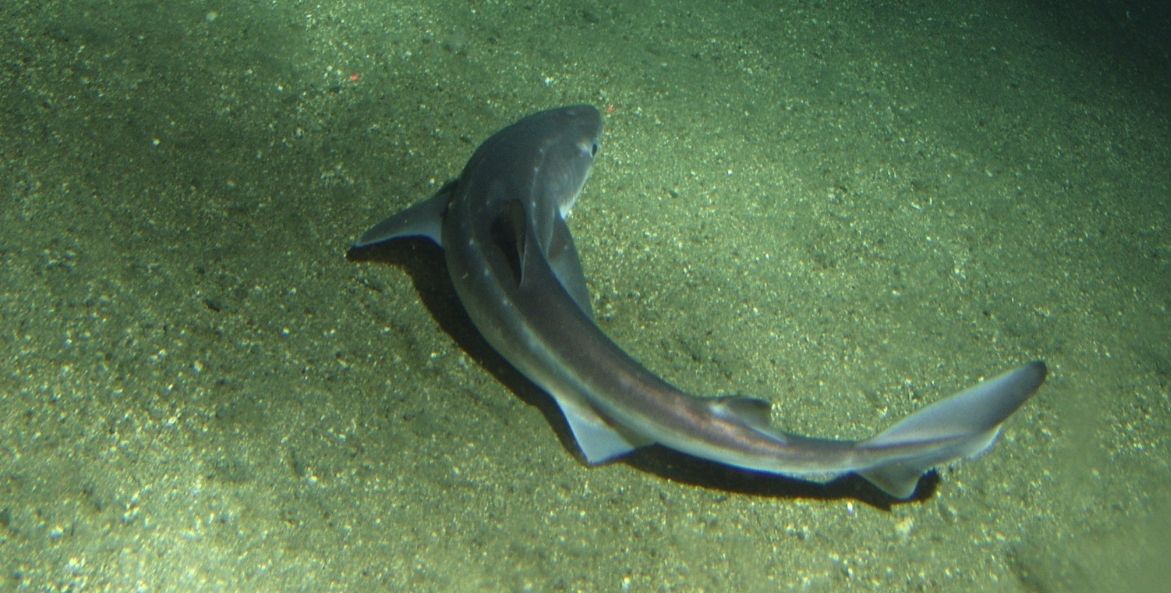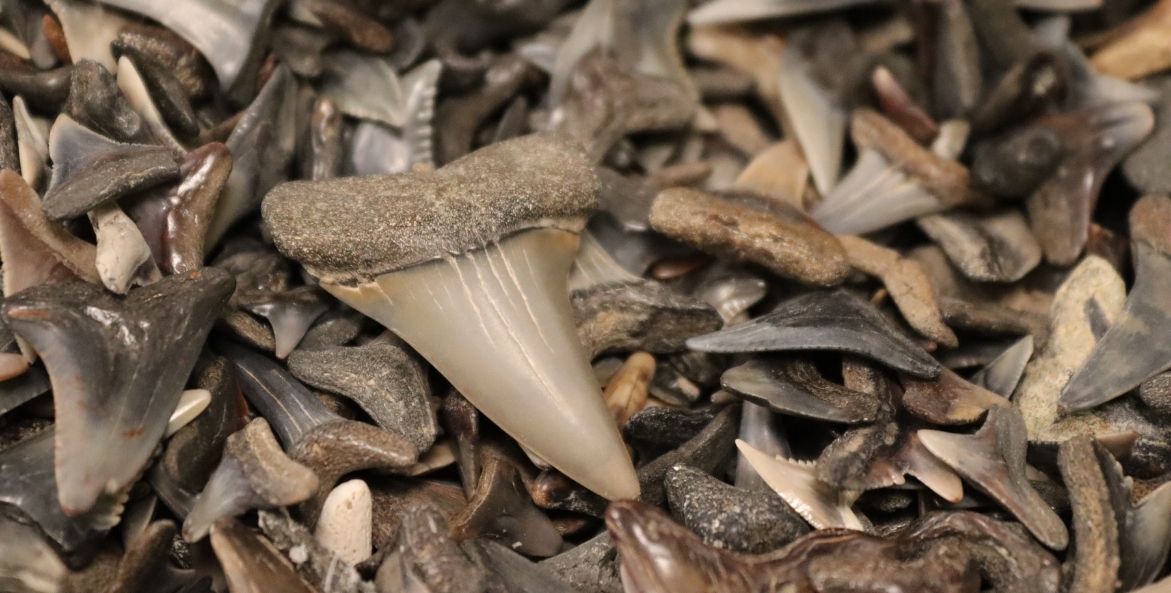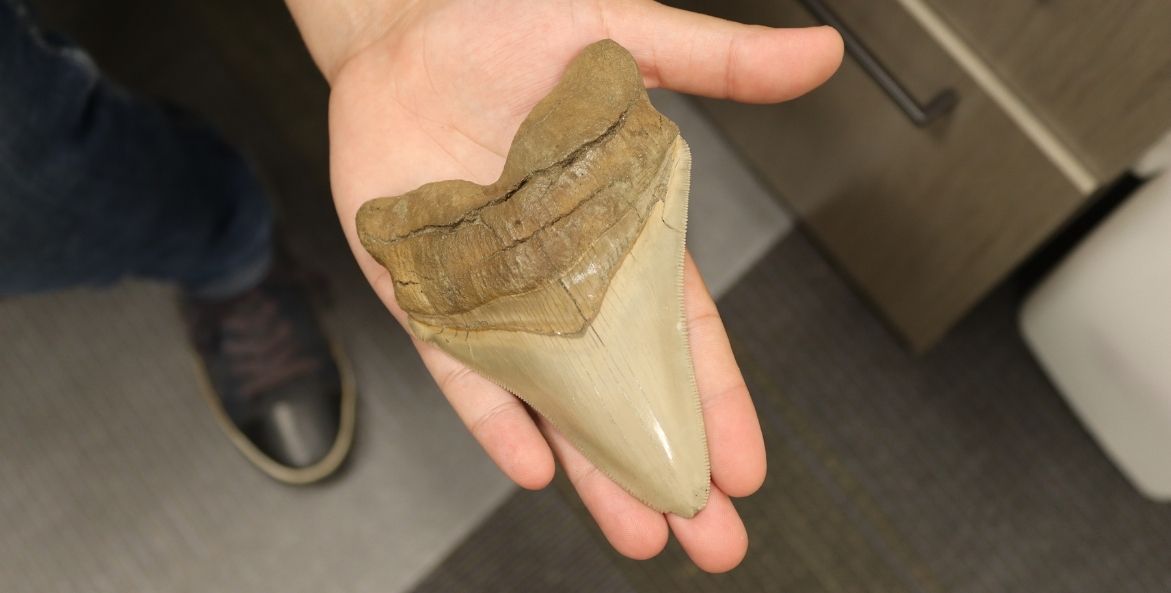We’ve all heard about sharks in the Bay, but did you know that these apex predators have actually been living here long before us humans ever showed up?
Megalodon (Otodus megalodon), the world’s largest ocean predator, called the Chesapeake Bay region home millions of years ago—20-7 million years ago to be precise. Its name “megalodon” means “big tooth,” and that’s no exaggeration. Megs were estimated to have been up to 65 feet long and we still find their fossilized teeth, which are sometimes as large as 6 inches, along local beaches.
So what made the Bay region an ideal habitat for this Miocene monster? And what can those early days of sharks in the Chesapeake teach us about their modern-day cousins? I headed to my old stomping grounds at the Calvert Marine Museum (CMM) in Solomons, Maryland, to find out.
My first stops at CMM, which also doubles as the Maryland Center for Paleontology Collections and Research, were with Dr. Stephen Godfrey and Dr. Victor Perez. If you’re looking to talk shop about the shark fossils found along Calvert Cliffs, there’s no better place to start.
As I walked into their offices, it felt like I had stepped into a museum within the museum. There were shark teeth and reconstructed jaws everywhere I looked.
Dr. Perez, who has studied sharks from the Chesapeake to Central America, explained that the Bay as we know it didn’t really exist 10 million years ago. Maryland’s entire Eastern Shore was completely submerged and sharks like megalodon inhabited waters that flooded over the Atlantic Coastal Plain. These sharks were believed to have roamed the globe, following food sources to ideal hunting grounds. Can you imagine a world so different?
Not only did megalodons change their location—over the 15+ million years they inhabited Earth, these massive creatures adapted in a number of ways. Megalodon was the final stage of evolution in a lineage of sharks called the megatooth sharks. One of megalodon’s early ancestors, named Otodus obliquus, lived around 60 million years ago. This early ancestor had teeth that were quite different from megalodon. Otodus obliquus had teeth that were narrow, with non-serrated cutting edges. These teeth were ideal for puncturing their prey and eating it whole. However, over time, megatooth sharks adapted wider teeth, with serrated edges, to feed on new prey—whales and dolphins. This simple, yet significant, adaptation shows us that even those at the top of the food chain need to evolve in an ever-changing environment if they are to survive. As Dr. Godfrey put it, “it doesn’t matter how big and powerful you are. If you can’t adapt to a changing environment, then you’ll become extinct. But the neat thing about life is that there’s this thing called evolution, and evolution is the antidote to extinction.”

Fossils like this dolphin vertebra with teeth marks help scientists determine what ancient sharks may have been feeding on. These specimens are on display at Calvert Marine Museum.
Anjelica Eitel/CBF Staff
Eventually, as with many creatures, megalodon’s evolution was unable to keep up. While there are several theories as to why these sharks became extinct, a popular one is that their prey—in this case, ancient whales—evolved more quickly and became exceedingly difficult targets for the meg. In the end, it may have been the shark’s highly specialized hunting practice and choice of prey that led to its downfall.
As they say, the more things change, the more they stay the same. We see similar adaptations with the sharks of today. Changes in water temperature and salinity content determine whether we see more or less sharks in Bay waters. This could mean that as we see warmer temperatures and slight increases in salinity due to climate change, shark sightings may become a more regular occurrence. CMM estuarine biologists Perry Hampton and Linda Hanna shared that there are already approximately a dozen different species of sharks found in the Chesapeake. Many of these inhabit the lower Bay, where salinity content is higher thanks to a closer proximity to the ocean. Some of the most commons types you’ll see are smooth dogfish (Mustelus canis), spiny dogfish (Squalus acanthias), and sand tiger sharks (Carcharias taurus). Sandbar sharks (Carcharhinus plumbeus) also spend much of their time in the lower Bay, and females even use the area as a nursery for their pups. In Maryland’s Bay waters, you won’t see nearly as many species—again, due to that salinity content. The one notable exception is the bull shark (Carcharhinus leucas). This species can range from 7 to 11.5 feet in length and weigh between 200 and 500 pounds, and they are known for tolerating environments with more freshwater. They’re also fans of warmer temperatures, so as waters become hotter, there’s a chance that we could see more sharks in areas like Southern Maryland.

Spiny dogfish are commonly found in the lower Bay south of the Potomac River. Males will grow just over 3 feet long, and females can reach 4 feet in length.
Rick Starr/NOAA CBNMS
Something to keep in mind, however, is that the presence of apex predators is almost always a good thing. When we find creatures like sharks and dolphins in the Bay, it means that the ecosystem is healthy enough to support a robust prey population. For example, bull sharks enjoy snacking on cownose rays, which eat oysters and clams, which rely on plankton to survive. While the thought of sharks sharing the Bay can seem frightening, it’s a sign that nature is balancing itself out.
But for now, how can us fin fans appreciate the sharks of yore? A few months back, we shared a nature journaling blog about proggin’—also known as beachcombing. In addition to sea glass and shells, we can find fossil treasures along many of the beaches that line the Bay. One of my favorite spots growing up was Brownies Beach, which is officially known as Bayfront Park, in Chesapeake Beach. Here, even the amateur fossil hunter can find dozens of shark teeth in an hour or so. This site is currently closed to the public, but keep it on your list for next summer. It’s worth the wait!
If you travel a little farther south along Calvert Cliffs, Flag Ponds Nature Park and Matoaka Beach Cabins are both great spots to enjoy the Bay and unearth ancient treasures. Head over to Charles County and you’ll find Nanjemoy Wildlife Management Area, formerly known as Purse State Park, a 217-acre site with beach access and even more spots for diving into the past. It is important to note that whenever exploring along any of these formations, you must have permission to be there and never dig into cliffs. As long as you’re following the proper protocols, enjoy the beach and happy hunting!

Shark teeth of all shapes and sizes are still waiting to be discovered. You just need to know where to look!
Anjelica Eitel/CBF Staff
Want to learn more? Check out these helpful resources:
- Sharks currently found in the Bay
- Fossil ID Guide
- Guide to fossil hunting along Calvert Cliffs
- "Sharks! Sink Your Teeth In!" exhibit at the Calvert Marine Museum




